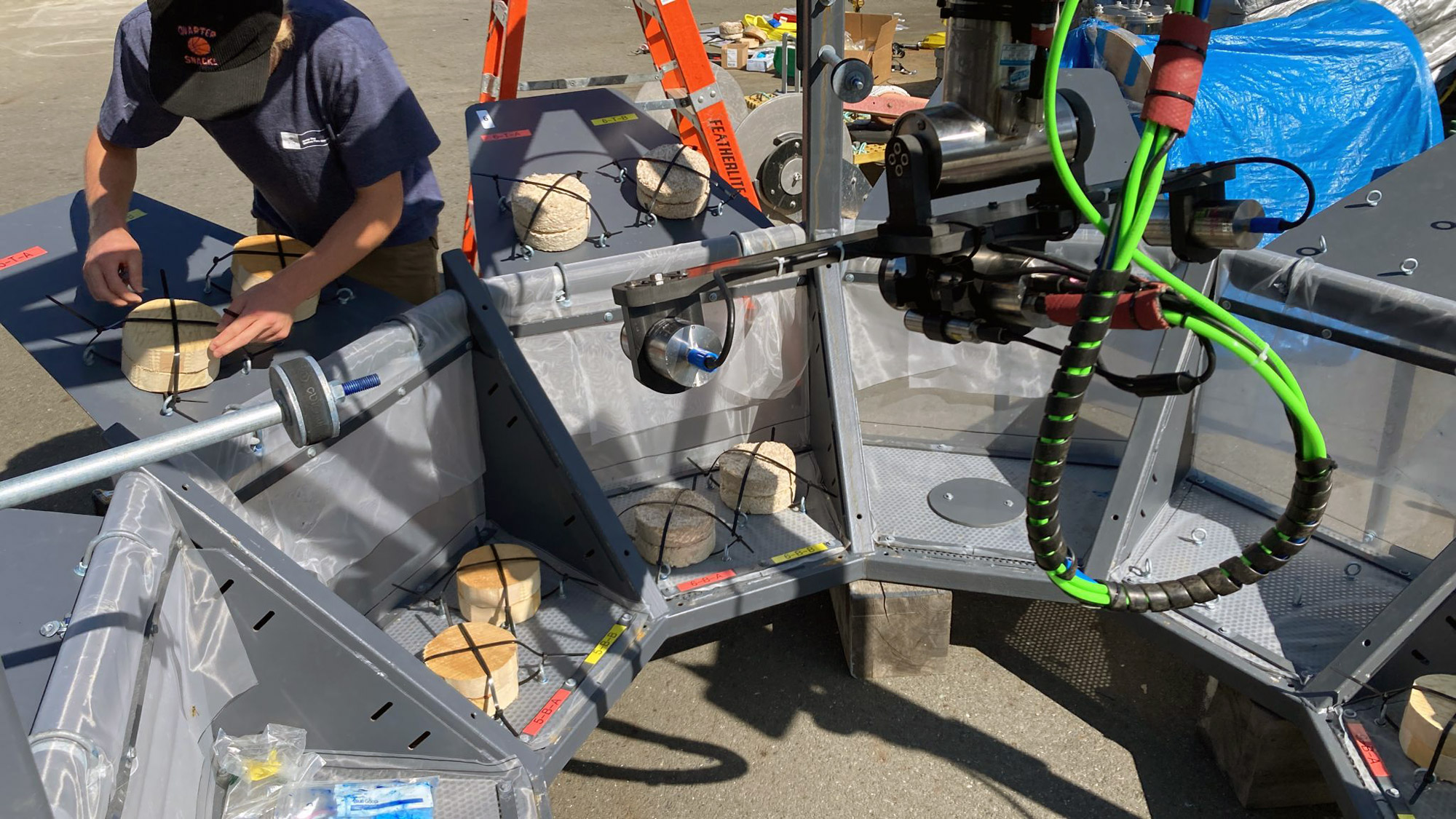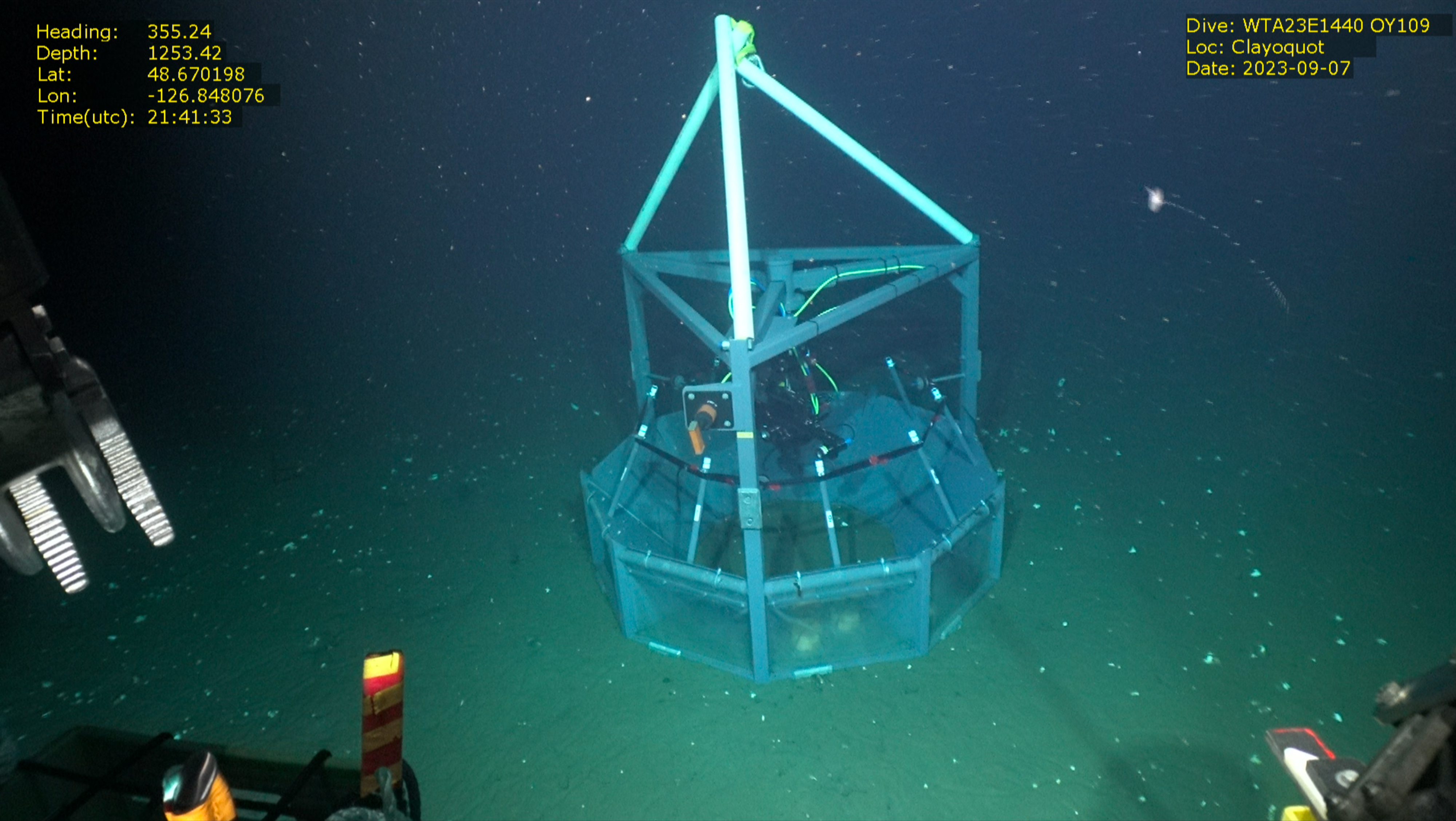Ocean Network Canada’s deep-sea observatory off the coast of British Columbia is now home to a new type of marine carbon dioxide removal (mCDR) research project that aims to harness the power of nature to combat climate change.
mCDR has a critical role to play in global efforts to slow the rate of climate warming by removing CO2 from the atmosphere. Like all emerging technologies, responsible research is needed into its impact, safety, and effectiveness as a climate change mitigation tool.
Ocean Networks Canada (ONC) is partnering with Running Tide, a US-based ocean health company, to investigate what happens to carbon-capturing biomass thousands of meters below the surface and its potential impacts on the deep-sea environment as it resides there. The project is the first of its kind to be trialed in Canadian waters and was made possible by ONC’s NEPTUNE seafloor observatory, which provides power and internet connectivity for the monitoring equipment involved in the research.
Under the spotlight will be Running Tide’s Carbon Buoys (made from wood and mycelium), which are designed to host algae (or seaweed) that capture and convert CO2 into algal biomass through photosynthesis. Once the surface floating buoy reaches a point of negative buoyancy, it is designed to sink to the seafloor.

Project engineers and scientists ready the benthic lander before loading it aboard the CCGS John P. Tully. (Image credit: Running Tide)
This project jumps ahead of the buoy seaweed growth phase by submerging the end product materials in an observation platform—or benthic lander—on the seafloor. The lander, which houses a mix of Carbon Buoys as well as pre-grown local seaweed in 18 compartments, was custom designed by ONC scientists and engineers, and deployed at NEPTUNE’s Clayoquot Slope site, at a depth of ~1,250 meters, during the ONCAbyss 2023 Fall Expedition.
“The biggest novelty of our design is that the lander’s shape is a nonagon. A nine-sided frame which includes a centrally mounted camera, capable of imaging 360 degrees,” says Kohen Bauer, ONC Senior Staff Scientist, “this will provide near-real-time imagery of the organic substrates in the environment over the course of the experiment.”
Over the next 12 months, real-time ocean data from the project, captured by the camera and underwater sensors, will be publicly available on ONC’s Oceans 3.0 data management portal. The environmental sensors are picking up metrics, including salinity, temperature, and dissolved oxygen.
Deep-Sea Observing
Scientific data will also be collected during ONC’s upcoming expeditions to maintain the NEPTUNE observatory, starting in spring 2024. Using a remotely operated vehicle (ROV), the researchers will collect water and sediment samples throughout the experiment to observe potential changes in sediment composition, as well as how the microbial community might respond to the presence of the Carbon Buoys and seaweed.
The potential benefits of such nature-based climate solutions could be major. According to the US National Academies of Sciences, Engineering, and Medicine, seaweed cultivation could remove around 100 million to 1 billion tons of CO2 per year. The Intergovernmental Panel on Climate Change (IPCC) Sixth Assessment Report describes how all reasonable scenarios that limit global warming to 1.5°C require large-scale carbon removal at an estimated rate of six to ten gigatons annually by 2050, in addition to deep decarbonization across all economic sectors.
ONC’s established deep-sea observatories provide a unique ocean-scale laboratory to monitor and assess the efficacy and fate of these sunken Carbon Buoys.
“This experiment will advance the scientific understanding of biomass falls in the benthic environment—a natural but currently under-sampled occurrence,” said Alison Tune, Leader of Running Tide’s Earth Science and Ecology team.
“Understanding the potential impact on seafloor ecosystems is critical for any carbon removal strategy that plans to durably remove carbon through sinking biomass. Partnering with ONC provides the opportunity to observe a marine environment that is very difficult to access and will help advance foundational science in this area.”
This research partnership is part of Running Tide’s broader research roadmap to understand the potential impacts on the environment—both positive and intended, but also the local potential risks to the environment. The company says it is critical to understand how the natural materials being deployed will store carbon over time and to know how these materials may impact organisms and the environment in the immediate vicinity.

Underwater image of the benthic lander at the Clayoquot Slope site. (Image credit: ONC/Pelagic Research Services)
ONC President and CEO Kate Moran says, “ONC is committed to enabling responsible research on ocean-based solutions for climate change mitigation,” she continues, “the Government of Canada has invested in ONC’s real-time, ocean observing infrastructure, making it the perfect platform to do real-world research of this kind and positioning Canada to lead the way in Monitoring, Reporting, and Verification (MRV) of mCDR research.”
Moran says that the ocean is already the big player when it comes to climate change mitigation, absorbing 30 percent of the CO2 and 90 percent of the heat.
“We have the infrastructure in place where we can help start-up companies conduct research to responsibly develop solutions using those enhancements of existing ocean processes, to remove more CO2 from the atmosphere, and keep the planet sustainable for the future.”
Ocean Networks Canada’s observatories have been monitoring the NE Pacific for nearly 20 years, providing valuable long-series data on how the ocean there is changing. This robust scientific data provides an environmental baseline against which to evaluate the impact and effectiveness of potential mCDR technologies and inform decision-making.
As a not-for-profit organization, ONC is partnering with industry to help grow the research community in Canada in support of a sustainable blue economy. ONC was connected with Running Tide to help advance this mCDR through the Launchpad program by Ocean Visions, a non-profit organization catalyzing innovation at the intersection of the ocean and climate crises.
To find out more about Open Ocean Networks Canada’s work in deep-sea carbon storage, visit: https://www.oceannetworks.ca/
This feature appeared in Environment, Coastal & Offshore (ECO) Magazine's 2023 Deep Dive III special edition Deep-Sea Exploration, to read more access the magazine here.





